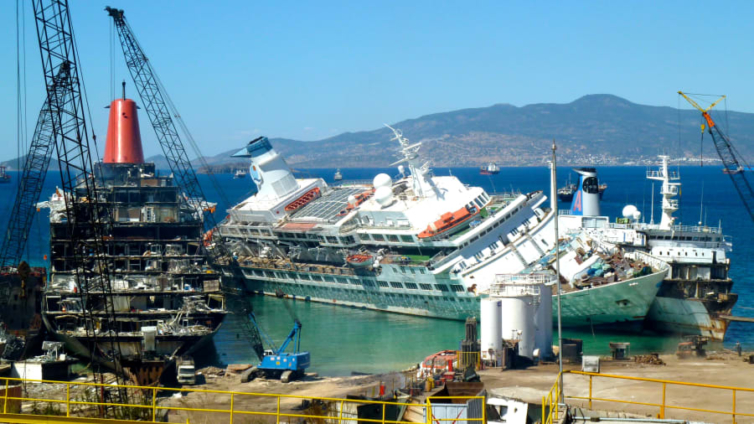Hundreds of cruise ships usually traverse the world's waters, but right now -- with the cruise industry on an indefinite hold due to the coronavirus pandemic -- they're mostly laid up at sea with no passengers.
Last month, cruise giant Carnival Corporation announced plans to remove at least six cruise ships from its fleet, with 23-year-old Costa Victoria earmarked for demolition.
When the cruise industry tentatively restarts, it'll likely be on a smaller scale -- and vessels that were once star players could end up bowing out early.But what happens when a cruise company decides to retire a ship?
Prior to 2020, the cruise industry was booming and ships could have a seafaring life spanning decades.If a major company decided a ship was no longer needed, it would likely sell the vessel on to a smaller corporation. Rebranded and perhaps refurbished, the ship would then continue operations for many more years.
Some ships are repurposed and become tourist attractions. "This is rare but does happen," says maritime history author Chris Frame, who points to the famous QE2 ocean liner, which sailed the seas from 1969-2008 and later opened as a floating hotel in Dubai in 2018.
But if there's little demand for ship buying, vessels will be sold for scrap -- a fate that could become more common in the wake of the pandemic.
"I don't know that many cruise lines in the world are looking to buy ships right now," Bill Miller, a prolific cruise ship historian, tells CNN Travel. "I would say that would be very unlikely. The next best buyer would be the scrappers."
Breaking down a ship
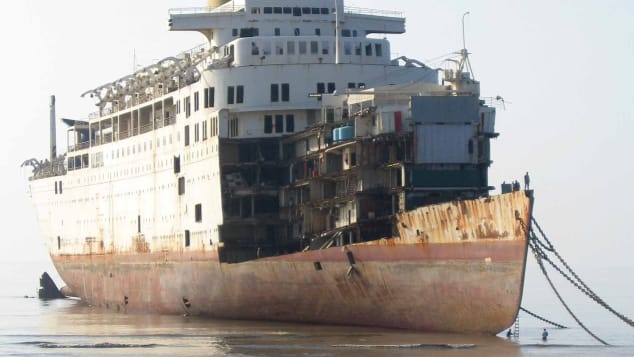
Courtesy Peter Knego
Cruise ships, especially in recent years, have become giant floating cities, chock full of features from casinos to swimming pools, rooftop bars and spas.
It's hard to imagine, but most will eventually end up in breaking yards such as Gadani, near the Pakistan port of Karachi, or Alang, India, where they'll be systematically torn apart.
When a ship's been earmarked for scrapping in somewhere like Alang, its operator will first remove anything it wants for salvage.
"Then a small crew, maybe about 50, will take it out to India," says Miller. "It's a very lonesome last voyage, because the ship is empty, no passengers, but yet it has the feel as if it's still a cruise ship, because all the furniture would still be in place. That's all sold in parcel with the ship itself."
In Alang, explains Miller, the crew will wait until tidal conditions are right and then deliberately run the ship aground on the beach.
When the vessel is stuck in the sand, final papers are signed, and the dismantling begins -- a process that can be fraught with risks both for the workers involved and the environment surrounding the scrap yard.

Courtesy Peter Knego
Freelance cruise journalist Peter Knego has visited Alang nine times and has also traveled to another shipbreaking yard in Aliaga, Turkey. Knego developed a fascination with ocean liners and cruising as a kid when he read about the Lusitania, the British ocean liner that sunk in 1915, and the interest extended into his adult life.
He first visited Alang in 2004, telling CNN Travel he spotted "10 historic former liners and first generation cruise ships" on the beaches on that one trip alone."
On the 10-mile stretch of beach, up to 200 ships can be demolished at one time, making it look like Armageddon or something out of a science fiction movie," says Knego. "Tankers share the sands with cruise ships, ferries, container ships and even outmoded oil derricks."
Once the cruise ship arrives at its final destination, everything inside must be removed, from the grand chandeliers to the toilets.
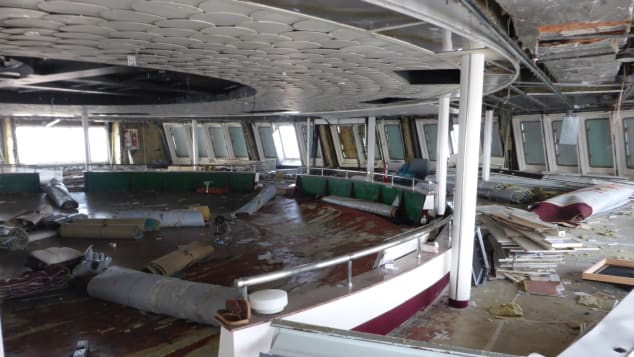
Courtesy Peter Knego
Knego says that many assets, such as furniture and lighting, will be resold locally.
Then begins the dangerous and involved process of dismantling the ship's superstructure. Some of the steel will be melted and reused in construction.
Knego's reasons for visiting Alang aren't just to witness the dismantling process in action. He's a collector, and his trips have been timed with the arrival of significant ships in the hope of claiming interior assets for himself.
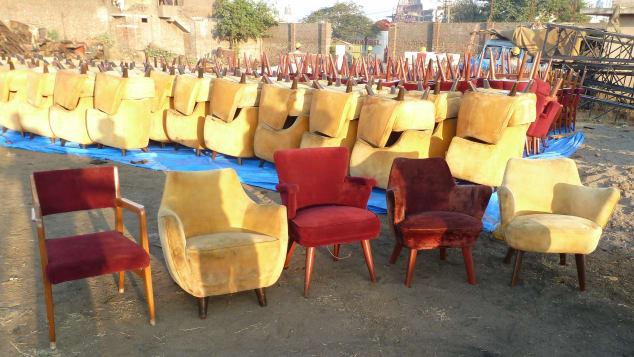
Courtesy Peter Knego
With the aid of a local agent, Knego gains access to the vessel, often climbing up a ladder, to scout the items he wants, then makes deals to buy them. These are then packed them into a container for shipping back to his home in the United States, which he describes as an "ocean liner museum."
"Every door, light fixture, railing, (almost) every bit of furniture and artwork is from a classic mid-20th century ship," says Knego.Step inside his house and you might spot artwork that once graced Carnival's first ship, the Mardi Gras, which first set sail in 1972. There's also paneling, lighting, ceramics and railings from ships including the 1950s-era MV Augustus and the 1980's Stella Solaris.Knego has got a particular place in his heart for vessels from post-war through to the mid-70s, and says the ships currently being scrapped -- which largely date from the 1980s and 90s -- aren't quite as exciting in his eyes.
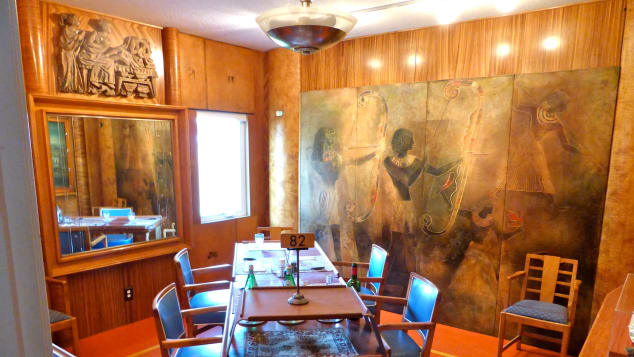
Courtesy Peter Knego
Items that don't have a place in his house go up on his website for sale. He says pieces are usually snapped up by ocean liner enthusiasts or collectors looking for mid-century furniture.
Knego says he hasn't bought anything from the Turkish breaking yard in Aliaga, but he's watched ships arrive there for their final reckoning, including the original Pacific Princess which appeared in the 1980s TV series "The Love Boat."
Knego says it's neither easy nor recommended to visit maritime breaking yards and doesn't disclose how he gains access.
Reports of poor conditions for workers at Alang last year prompted regional authorities in India to pass new legislation to try to protect their welfare. The 2019 Recycling of Ships Bill also attempted to control the impact of hazardous materials exposed during the dismantling process.
Knego's photographs concentrate on the contrast between the beach, industry and nature.
"To see such large objects on a beach being demolished in an otherwise natural setting is both fascinating and heartbreaking," he says.
Reimagined ships
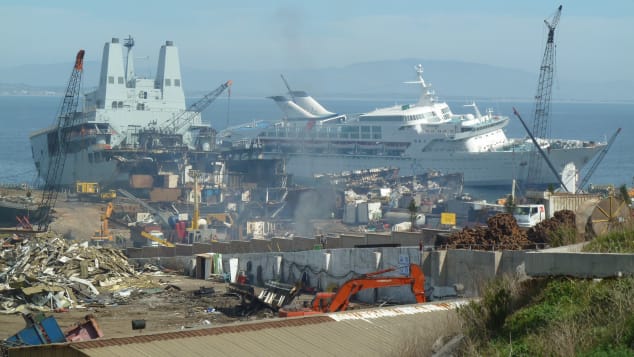
Courtesy Peter Knego
In the wake of the pandemic, there's been talk of how cruise ship interiors can be reimagined to protect from the Covid-induced lockdowns that characterized the first half of 2020.
Cruise ships have always been regularly refurbished to bring machinery up to date and refresh interiors.
Maritime historian Chris Frame points to the Royal Caribbean ship Enchantment of the Seas, which was lengthened in 2005 from 916 to 988 feet.
"The new section added more cabins, more space for a water park style pool deck, extra bars and lounges," says Frame. "Traveling aboard, the only sign that there was a change made are the lines where the welding took place -- but if you didn't know to look for it you'd never know."
There has been talk of future cruises abandoning self-service buffet restaurants, keeping public spaces emptier and reducing the number of passengers aboard.
And even months into the cruising pause, not every ship is in its final spot. Some have been transporting crew members home by sea. Others are traveling elsewhere to a safe spot to lay up.
When cruise ships are idle, they can either be in what's called a "hot layup" or a "cold layup."
Hot is the short term solution.
"In other words, the ship would be kept ready to get back into service fairly quickly," explains Miller.
Cold layup is when the ship is largely shut down and is intended to be so for months or a year, with only a reduced crew on board.
"Those that are in cold lay up are vulnerable," says Miller. "Because if in six months the market isn't strong enough, they may reconsider and say, 'well okay, we're not going to bring this ship back after all, we're going to sell it for scrap.'"
As well as the hundreds of cruise ships anchored with return dates unknown, there are also billion-dollar ships that have yet to even make it into service, including Scarlet Lady, the inaugural vessel of Richard Brandon's Virgin Voyages cruise line.
"There's likely going to be an excess of ships available when cruising restarts," Chris Frame says.
At this stage, the future of the cruise industry is uncertain, although the world's cruise companies will be keen to bounce back from months of inactivity, concerning reports about crew welfare and dissatisfied passengers.
But both Frame and Miller note that cruise companies such as Cunard and P&O Cruises have long histories and survived past health crisis, wars and changing travel habits.
"Like those facing challenges in the past, cruise companies today will need to adapt to this new environment," says Frame. "After having enjoyed years of growth, this will be a big shift. But one I think the cruise industry is capable of achieving."
Miller adds: "I think the return will be a slow one when it comes back. It'll definitely come back, but it'll be sluggish. It's not going to go gangbusters the very next week. So cruise lines are looking at cutting, trimming staff operations and getting rid of some ships."
Latest Stories
-
At least 24 dead after two boats capsize off coast of Madagascar
21 mins -
Madina MP lauds White Chapel Youth Group for championing peace ahead of elections
33 mins -
Man United settle for draw at Ipswich Town in Amorim’s first game in charge
1 hour -
GPL 2024/2025: Prince Owusu screamer earns Medeama win over Young Apsotles
1 hour -
BBC visits mpox clinic as WHO says DR Congo cases ‘plateauing’
1 hour -
Burning old TVs to survive in Ghana: The toxic trade in e-waste
2 hours -
Perfume boss admitted he ignored Russia sanctions
2 hours -
Wicked proves popular as opening set to be biggest for Broadway film
2 hours -
Nominee for agriculture secretary completes Trump cabinet
2 hours -
ECG urges prepaid customers to top up to last one month ahead of system upgrade
2 hours -
Three more tourists named in Laos methanol deaths
3 hours -
Betway Africa offers a once-in-a-lifetime ‘Play-on-the-Pitch’ experience at Emirates Stadium
3 hours -
The rise and fall of Matt Gaetz in 8 wild days
3 hours -
School Feeding Programme: Bono East NIB seizes smuggled rice, arrest driver
3 hours -
Dr. Razak Opoku: Despite challenges, facts and data still prove NPP is better manager of the economy than NDC
3 hours

